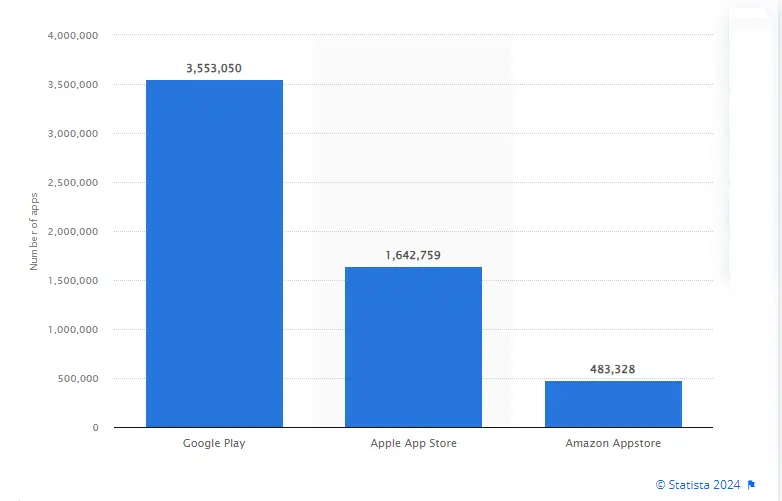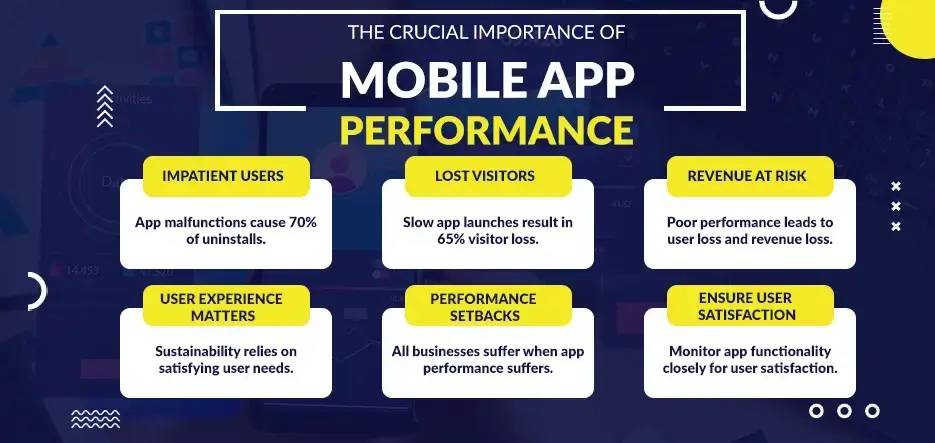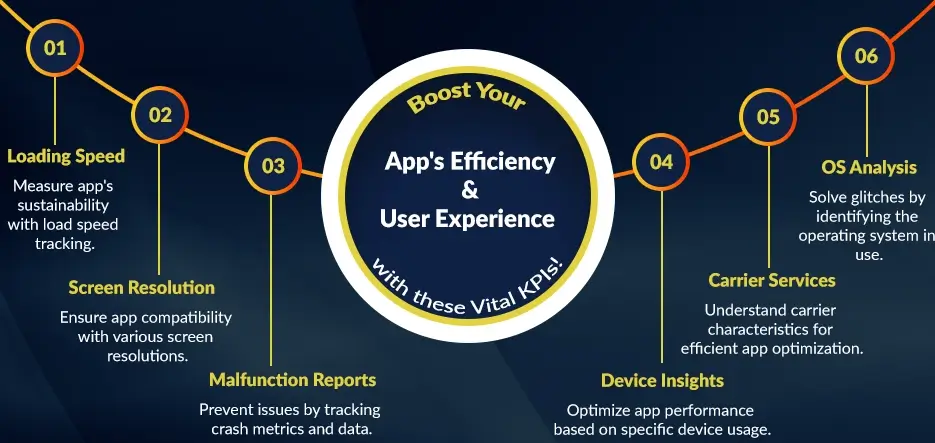Engaging users and growing a brand are both easy to do with mobile app development companies. The most important element in determining a mobile app’s effectiveness is its performance. An app that performs badly won’t keep users and therefore will collapse shortly. To guarantee the profitability of the app as well as your company, it is crucial to monitor and grow the performance of the app.
Compared to the slightly over 2 million apps that are accessible in the App Store, Google Play offers over 3 million apps. Due to the intense market rivalry, one should always make sure the application is thoroughly streamlined for performance.

Table of Contents
App Performance: Is It Important?
The most important feature that every custom mobile app development company needs to focus on is performance. Users will repeatedly comment on how long it takes for your app to start up. And if the app is too slow, they will probably give it a negative review. Poor application performance usually persuades a majority of users to remove their apps, according to various sources. The unfortunate reality is that barely 45 out of 100 Android mobile apps launch in under 2 seconds, while the remaining 55 would launch in excess of 3.
It’s widely believed that Android smart devices have several cores, making it challenging for IT Consulting Services to create slick Android apps. It’s actually not true, in essence. The hardest part of using Android is deciding which choice is best because there are so many things you can do. You need to understand what’s going on in the background if you would like to boost the revenue of Android App Development Services.
Thankfully, a variety of tools are available to assist you to identify bottlenecks and demonstrate and measure what has been occurring. So it’s time that you stop depending on intuition or relying on luck and figure out how to make an Android app perform better in order for it to win over users. In this article, we’ll gain some insight into enhancing the procedures of top flutter app development companies.
We’ll discuss mobile app performance, illustrate why it’s significant, outline the metrics you should monitor, and offer some practical solutions that can be implemented to enhance the app’s performance.
What is meant by the performance of a mobile app?
The efficiency with which an app functions on a phone or tablet under varied workloads, as well as conditions, is referred to as mobile app performance. It may become necessary to track how long it takes an app to open, prevent crashes during periods of high user interactions, or keep an eye on battery life.
The device, network, server, and coding of the application are some of the variables that affect performance. However, how users ultimately view a mobile application’s performance is perhaps the most crucial statistic for gauging its effectiveness.
The perception of the users could make or break the app. You must make sure you’re considering it while making performance enhancements because it has the power to popularize mobile application consulting services.
What makes the performance of mobile apps crucial?
Brands must offer seamless and secure experiences as this world becomes progressively more digitized. People’s patience is infamously short when apps don’t operate properly and effectively. App malfunctions are to blame for 70% of application uninstalls.

An application that takes too much time to launch loses 65% of visitors. These kinds of figures are typical and give a very comprehensive vision: one should prioritize how to improve app performance in overall strategy implementation. Without so much as an identifiable plan of action to guarantee the mobile app’s performance is up to the standard, you run the risk that you’ll lose users and, consequently, revenue.
According to custom app development services experts, the sustainability of any mobile app ultimately depends on the user experience they seem to have. You may lose a user if they are not getting what they need after using your app. Applications across all businesses get down because of the performance setbacks. You must keep a close eye on the mobile app’s functionality to make certain that users are getting what they want.
On the other hand, when the app is functioning efficiently, the users are probably using it more. They are most likely to spend additional time as well as money on it. As per various researchers, rapid response times lead to higher conversion rates. Your engagement rate will be on the top as a result of giving your mobile app’s performance prime importance.
What makes it so essential to speed up app loading?
It is essential for best mobile app development companies in USA to optimize because the performance is influenced by the speed and launch time. According to statistics, an app’s average load time should be no longer than two seconds.
In fact, 53% of visitors actually leave a mobile app that takes greater than 3 seconds to launch, as stated by Google. Launch time of up to 4 to 7 seconds may be appropriate in this case. However, if the waiting time lasts for more than 12 seconds, it might become extremely irritable and unacceptable. Subsequently, the likelihood of losing customers as well as users rises as the volume of seconds does as well.
The custom mobile application development company in the USA says an app must instantaneously grab their attention and leave a lasting impression. Given below are a few key pointers which state that speeding up apps and decreasing their load times are crucial:
- Increases users’ willingness to use and engage with the app.
- Maintains their attention for extended periods on the app.
- Strengthens while also having an impact on the app’s performance.
- Improves user experience and tends to increase traffic.
- Minimizes churn, ricochet, and app alienation rates.
- Promotes traffic, profitability, and engagement rates.
- Integrates your brand’s reputation, worth, and application quality.
How do you make an app productive?
You must manage and control numerous variables since smartphone app performance is more widespread than just speed:
- Rapid launch time of the app (anywhere up to 2 seconds).
- Compatibility levels of the mobile app with the device requirement include but are not limited to display resolution.
- Sufficient storage as well as battery drainage.
- Ease of navigation through User Interface as well as User Experience.
- The mobile app isn’t losing crucial data and processing while running in the background.
- Seamless integration with 3rd party apps as well as components and services such as Bluetooth, camera etc.
What are the causes of issues with app performance?
The top iOS app development companies here in the USA considers application primary thread as well as interface incompatibilities are a few of the common issues of applications that need to be taken care of.
Systems Aspect
- Consistent HTTP request actions, receiving a significant amount of irrelevant and big quantities of information from the server.
- API-oriented latency, inconsistencies, and data compression.
Primary Thread
- Database operations are carried out in massive amounts on the application’s main thread.
- Inaccuracies in database design and data extraction methods.
Interoperability
- Inappropriate shadow rendering methods on interface elements.
Some of the best enterprise app development companies consider these would be, in a nutshell, among the most prevalent and typical causes of app performance problems or reasons why the app could be slow. Many times, each solution has its own set of special circumstances.
How to evaluate the performance of a mobile app?
Accessibility to user statistics as well as other metrics is necessary for evaluating the effectiveness of your mobile app.
As per the top enterprise mobile app development, you’ll be capable of creating procedures that ensure that any irregularities in the metrics being monitored for the performance of your app are addressed.
In the situation of a disaster, you won’t be able to figure out what went awry without the methods of tracking the performance indicators. For example, if you keep a record of the number of new signups you’ve acquired over the past year, you’ll be more likely to understand why there has been such a sharp fall.
The mobile app consulting companies states that there are several ways to gauge the effectiveness of a mobile app, but in the end, you’re concentrating on various KPIs. They consist of:
Generic app KPIs
Since they do not necessitate technical expertise in mobile app technologies or programming, generic app KPIs may frequently be monitored by anybody.
Depending on how the app functions and what it aims to do, different KPIs will have varying degrees of importance. For example, a subscription-based app won’t be concerned with how many times the application has been downloaded independently. Instead, they would focus on user interaction.
Listed below are a few examples of typical smartphone app KPIs you must track to assess the app’s performance:
Number of Downloads
The quantity of downloads a mobile app receives is usually strongly correlated with its success. Having said that, this statistic may be somewhat broad. 20 million downloads of a networking app are not equivalent to 1 million downloads of a paid membership service, for example.
Number of New Users
You should monitor both the number of new users who download your app as well as the rate at which the customer base is expanding in order to accurately assess how effectively it is performing. You should be able to identify their source if your app has an unexpected spike in users. Knowing the origin makes it possible to gauge the effect and maybe reproduce the formula in the long term.
You can forecast future profitability by tracking the expansion of your app’s customer base. Precisely add up the total number of users who log in every day over a certain amount of time. This figure can then be utilized in future strategy and planning.
Rate of Organic Conversions
The pace at which users get in conversion by you through unpaid methods is known as the organic conversion rate. This could be in process by verbal, and social media references, news releases, organic traffic, and more. You can monitor the outcomes of your organic efforts by monitoring this KPI. You can calculate your return on investments by determining the conversion rate of the non-paid sources. A more efficient plan of action could help your promotional strategies if you’re using such metrics
Rate of Paid Conversion
You can spend money on a variety of methods to increase your conversion rate. You can use paid advertisements, such as sponsored posts on Instagram or paid tweeting, to achieve your objectives more quickly. Just as important as determining your organic conversion rate in determining your rate of conversion for paid channels. You need to be aware of the type of returns on investment you’re generating when money is being spent in various ways. In exchange, this will enable you to make more informed financial decisions going forward.
Number of Uninstalls
As per the top leading mobile app development company, regardless of how enthusiastic a user is, he could eventually lose interest in your application. People deleting apps is a part of everyday life, but if you observe a surge, this could also hint at a vulnerability. This is the reason it’s crucial to keep track of the uninstalls. In essence, uninstalls allow you to keep an eye on the health of your app. If an excessive number of users are abandoning your mobile app, this may point to a performance problem, which you should address right away.
Ratings and Reviews
The better your score, the better it will be for the smartphone app. A positive user review shows how useful your app is to the users and it could also show how well your customer engagement methodology is functioning. Bad reviews should also be monitored when monitoring this indicator. These should provide you with a greater understanding of the significant modifications you should be contemplating.
Customer Reach Versus Impressions
While impressions refer to the number of times the content was exhibited, reach represents the total number of people who came across it. When keeping an eye on both indicators, you should be aware of their differences. In a broad sense, your reach must be given a higher priority because it shows more clearly how real individuals are being reached by the content. Though impressions are still significant, the overall reach is more crucial.
Productivity-Oriented KPIs & UX
The top mobile app development companies in USA state that one may gauge the app’s operating efficiency using these metrics. Improvements that will enhance the user experience while also improving the technical performance of your app by adhering to these KPIs. In general, you’ll need to have some technical knowledge to comprehend these KPIs:

Rate of Loading
As the world is growing increasingly technological, users are losing patience with apps that take a long time to launch. People now demand rapid loading, and the majority of the time they get it. If your mobile application isn’t following the rules, you need to address the problem right away. For an accurate assessment of the app’s sustainability, you must keep track of the load speed. You run the risk of losing users to frustration without a reasonable load speed.
Display Resolution
Knowing the most common screen resolutions can help you better ensure that your mobile app meets the requirements of smart products. In order to create an app that functions as intended for every user, it is crucial to keep track of their individual screen resolutions.
Malfunction Reports
Apps may malfunction. It happens to be a universal truth. To thoroughly test every scenario, there seem to be just too many gadgets, software platforms, and parameters. It’s possible that the user was using the application in a manner it should be. Certain operations of the app might not get done by an operating system. For any cause whatsoever, crash metrics are closely in track by the experts. You can prevent issues from occurring again and guarantee the continued accessibility of the app by keeping track of crash data.
Gadgets
The top Android app development companies expert explains that you must monitor the platforms that your target market uses to access your app. Do they have smartphones or tablets? Do Android users outnumber iPhone users? Which device must have seen the greatest use? You will be able to adjust the performance of your app based on the features of particular devices once you get the responses to these inquiries.
Carriers Services
Knowing what carrier your target market uses is just as important for optimization as knowing what device they use. Features offered by various carriers can vary, especially factors like internet speed. If you want to efficiently optimize your app, you must have a thorough understanding of these characteristics.
Type of OS
Fixing significant problems like malfunctions demands an understanding of the operating system a gadget seems to be using. For instance, if more iPhone users are experiencing crashes, the app has probably not been adequately designed by the iOS App Development Company.
What are the best ways to enhance the performance of your mobile app?
Now that you’ve become aware of the significance of optimization for mobile applications and several of the KPIs you should be monitoring, let’s look at some strategies for enhancing the performance of your mobile app’s functionality:
1) Speed up APIs by using CDN
Information from other apps is on the move using APIs. If you’re familiar with weather apps, you know that an API was working overtime in the background to gather and present the 3rd party data. Content delivery networks, or CDNs, are useful tools that can assist an API to operate more quickly. A CDN speeds up API connectivity by using servers located all over the world. The utilization of an edge server that seems to be physically close to the user reduces latency, trip time, load, as well as capacity. In essence, the API’s speed increases because the proximity to the user is going down.
2) Image Optimization
The bigger the images, the longer it will take to load and the longer it will take for your app to try to showcase them. The images will experience a shorter load time if you properly optimize them. Here are the most crucial elements:
Compression: It is the practice of using reduced bits to encode digital images. It fundamentally reduces the image’s file size with no resolution loss and generally very little quality degradation. Within mobile apps, all photos must be compressed in some way or the other. As a result, the load time is minimized.
Resizing: Images must have their resolution changed in order to be resized. For instance, pictures that have previously been produced for printing are sometimes considerably larger than they are required to be for digital readout. You can save priceless bytes of memory by resizing these pictures for the dimensions of smartphone devices.
Caching: The act of caching involves obtaining images from the web and storing them in a smartphone’s memory. The smartphone app won’t have to fetch it from the public networks each time it is presented once it is on the gadget itself. Rather, it’s going to be able to utilize its own local storage, which is a quicker and more cost-effective choice that will speed up the loading speed.
Each of the above optimization strategies helps a mobile app load assets with less effort. The ultimate result is significantly faster load rates as well as a streamlined user experience.
3) Avoid Unnecessary Functionalities
It’s crucial to remove as much unnecessary functionality from the capabilities of a mobile app as you possibly can. For the sake of improving your overall efficiency, you must think about removing features that are no longer absolutely necessary to the operation of the app. The app should be responsive and lightning-quick. Apps with unnecessary functionality typically take longer to load and perform poorly. Make absolutely sure every functionality in your app is necessary before adding it, and take anything out that is not. Your subscribers will be delighted.
4) Break Down the Data Loading
You should take into consideration assemblies that help in breaking down the data into conveniently retrievable bits rather than processing big chunks of data at a time. This enables you to prioritize the app’s most crucial configurations first while loading the less crucial ones only when necessary.
5) Establish an Offline Setting
You’re enabling the user to retain their info and access it later when they’re connected by providing an offline mode. In essence, it denotes dependability, data security, and user comfort.

6) Make Code Improvements
When a custom mobile app development company is building applications, clean coding techniques are essential. Keep in mind to keep the code as compact as you can while still adhering to quality standards. Prior to launching, your code should be compressed. Any unnecessary spacing and remarks that could prolong the duration it takes for the app to load are eliminated through compression.
7) QA Testing Services on Several Platforms
If you need to guarantee that your finished product will operate as intended on any device that your subscriber base owns, you would like to incorporate QA Testing Services. This will offer you a sense of how efficiently the app performs with varying battery capacity and technology configurations, delivering a seamless user experience under various conditions.
8) Malfunction Monitoring
There are multiple explanations for crashes. It’s your responsibility to determine how they occur and take steps to prevent them from occurring again due to the same cause.
9) Show the Loading Process
Even though showing a loading stage doesn’t actually shorten the loading speed, it does influence how long users feel they have to wait. Users can be encouraged to wait when they see cheerful graphics or encouraging text as a page is being loaded.
10) Better Judgment
As per the mobile app development services experts, minimize the number of steps necessary to accomplish the same task by using careful planning. If the app is supported by a server, attempt to place the bulk of the workload there rather than processing all of your reports and data on a local level. Utilize additional database operations to get the information ready for utilization if you are retrieving the data from a local system in order to enhance your operations.
11) Incorporate Threading
Leverage parallel tasks and threading techniques like Coroutines and RxJava.
RxJava makes it simple to connect to one thread while keeping an eye on the other. Also, keep in mind to delete all of the users in the ‘onCleared/onDestroy’ action. You may initiate the task with the help of the IO thread and conclude it through the Main thread while using coroutines to leverage threading in a professional way.
12) Sub Modelling the Information
Never feel hesitant to develop and utilize sub-models when obtaining data from a database or an API. Through this, we imply that if you’ve got a list with 50 fields and all that you want to display is a small number of them, say 4-5, there’s no need to bombard the channels or clog the RAM; instead, just generate a sub-model of such primary model and get the data you require right away. The same approach could be utilized for databases; simply pick the relevant data you require.
13) Close All Open Correlations
When you hire mobile app development firm, they will update it’s never a good idea to leave the connection open because it could lead to errors, memory overflows, deadlocks, and even the freezing of your app. Instead, kill all open connections when you’ve dealt with them.
14) Make your UIs Simpler
Try to make the UI cleaner at the XML level; as you dive in deeper, things develop more slowly. Minimize the complexity of the UI to make the app render more efficiently. Constraint structure is fantastic for this, and recommendations can be quite helpful.
15) Connect your Opinions and Facts
Implement data-binding and view-binding to directly integrate data with the user interface.
16) Paging Techniques
As per the best mobile app development company in the USA, using paging in the adapters is a poor strategy to demand entire data in one go. If the database has 100,000 entries, not even the most expensive device will be able to process it.
17) Layouts and Drawable
Do not have any concerns regarding the app size; it could be managed. Distribute the layouts and drawable by the display size. A 5-inch budget smartphone isn’t the same thing as a 65-inch Smart LED TV, but Android is sophisticated enough to determine a drawable or layout that works perfectly with the display size.
18) Stay True
Test your app on a real low-end gadget, or use a customizable emulator for Android, the built-in or preset emulator is too good to be used. You could also opt for React Native App Development Services that ensure seamless performance.
Book 30 Minutes Free Consultations with A3Logics Experts to Start Your App Journey Today!
Summary
The revenue models of custom mobile app development companies in the USA will collapse if the user experience is poor. Enhancing user experience and, subsequently, user retention requires optimizing the performance of the mobile app. You now possess all the knowledge for creating a detailed plan for enhancing every aspect of the performance of the mobile app.
It has become one of the top trending apps in USA and one of the most fundamental prerequisites for a successful product that people appreciate and engage with is the potential for a spectacular performance. To figure out the reasons why the application’s performance is substandard and take appropriate corrective actions, we recommend regular monitoring of the app’s performance using APM tools.
If you’ve successfully completed the list of requirements but the app is still performing inadequately, you must reach out to IT Consulting Services to conduct a more comprehensive app productivity evaluation to determine the underlying problem and professionally resolve it.
Regardless of what kind of application you are building, every single user is valuable and significant. Don’t ever let revenue slip through your fingers because of not customizing the app to work with all kinds of technology and witness your app get beyond the best in the market in no time.
FAQs
Does the design of the API have an effect on the app’s performance?
Yes, a smartphone app may suffer from an underdeveloped or hastily built API. Quick fixes for APIs typically put an excessive amount of strain on the network’s functionality.
How to optimize display size for multiple platforms?
Screen size optimization for multiple platforms can be achieved by choosing customizable emulators over in-built versions.
What are some optimizations related to memory usage?
When developing apps, keep in mind that RAM is limited and that background apps can consume excessive bandwidth. This can be optimized through the following:
- Employing an intent server to shorten the lifetime of the
- Releasing the UI assets when users switch to a new UI
- Making use of memory-saving code techniques
- Reducing the use of certain additional libraries.
How would an iOS App Development Company boost app performance?
Here are a few ways to ensure proper optimization to boost an iOS mobile app performance:
- Embedding smaller amounts of Dylibs
- Consolidation of Objective-C categories
- Increased usage of Swift
How do Android App Development Services perform optimization of their apps?
As per experts providing mobile app development services in USA, listed below are a few techniques to guarantee that an Android mobile app is properly configured to improve performance:
- Creation of several views
- Running dynamics






